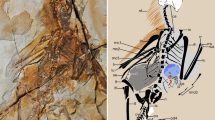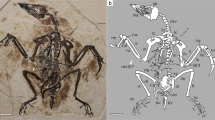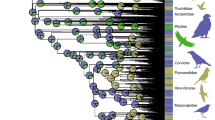Abstract
Padian and Dial1 challenge our view that the evolution of flight involved a four-winged stage. This disagreement stems from our different views on the origin of bird flight and from the methodology we use to analyse functional morphology in the non-avian theropod Microraptor2 and in an enantiornithine bird3 from the Early Cretaceous period in China.
Similar content being viewed by others
Main
Although the wing produced the main force for lift and thrust in the new enantiornithine bird, the curved shaft and asymmetric vanes of the leg feathers indicate that they could still produce some lift and thrust, as well as reducing drag. The arboreality of this bird is indicated by the curvature of the pedal claws and toe proportions4. It is not self-evident that small non-avian theropods were good runners: indeed, some of them may actually have been arboreal5,6.
Contrary to Padian and Dial's assertions1, attachments of leg feathers to the external side of the leg bones (tibia or metatarsals) have now been documented not only in Microraptor gui but also in Archaeopteryx7, Confuciusornis8 and several enantiornithine birds3,8, which would have enabled them to be extended into the lateral plane to produce some lift.
Padian and Dial argue that there is no evidence for a four-winged stage in flight origin. Leg feathers first appeared in non-flying theropods, which may have conferred some aerodynamic advantage, judging by their asymmetry and by the presence of an alula in the forelimb. So the original function of leg feathers might have been for gliding. We agree with Padian and Dial that these feathers were probably not used for active flight in Microraptor or in early birds. Although long leg feathers are found (but not to assist flight) in many living birds, these do not show the asymmetry or curved shaft indicative of aerodynamic properties.
The absence of aerodynamic function in leg feathers in modern birds does not mean that it did not exist in their ancestors. Reduction of drag is probably one of the main functions of the leg feathers in Microraptor and early birds, and modern birds such as kittiwakes use the leg feathers on their extended hindlimbs as well as their webbed feet for this purpose.
Although we believe that leg feathers had some aerodynamic function in Microraptor and that this was weaker in early birds, they were probably not the main flight apparatus. However, their role in the origin of bird flight should not be ignored — functional inferences should be based mainly on functional studies, not on phylogenetic brackets9.
References
Padian, K. & Dial, K. P. Nature 438, doi:10.1038/nature04354 (2005).
Xu, X. et al. Nature 421, 335–340 (2003).
Zhang, F. & Zhou, Z. Nature 431, 925 (2004).
Zhou, Z. & Farlow, J. in New Perspectives on the Origin and Early Evolution of Birds (eds Gauthier, J. & Gall, L. F.) 237–254 (Yale Univ., New Haven, 2001).
Xu, X., Zhou, Z. & Wang, X. Nature 408, 705–708 (2000).
Zhang, F., Zhou, Z., Xu, X. & Wang, X. Naturwissenschaften 89, 394–398 (2002).
Christiansen, P. & Bonde, N. C. R. Palevol. 3, 99–118 (2004).
Zhou, Z. & Zhang, F. Vertebrata PalAsiatica (in the press).
Zhou, Z. Naturwissenschaften 91, 455–471 (2004).
Author information
Authors and Affiliations
Rights and permissions
About this article
Cite this article
Zhou, Z., Zhang, F. Could ‘four-winged’ dinosaurs fly? (Reply). Nature 438, E4 (2005). https://doi.org/10.1038/nature04356
Published:
Issue Date:
DOI: https://doi.org/10.1038/nature04356
Comments
By submitting a comment you agree to abide by our Terms and Community Guidelines. If you find something abusive or that does not comply with our terms or guidelines please flag it as inappropriate.



